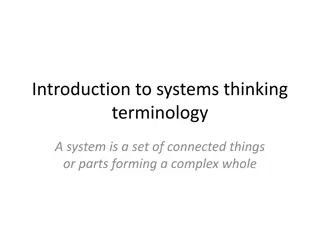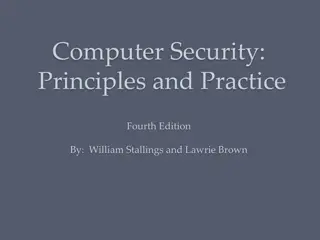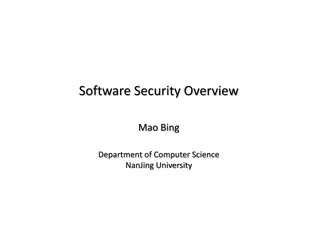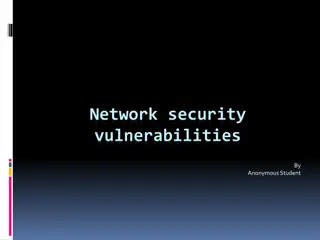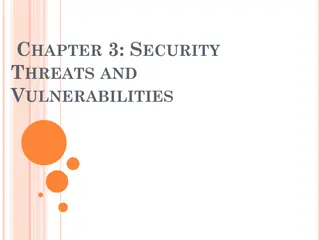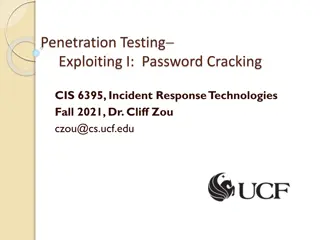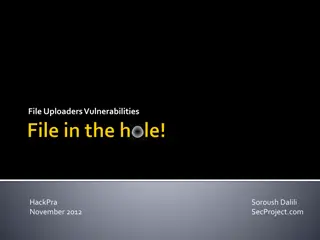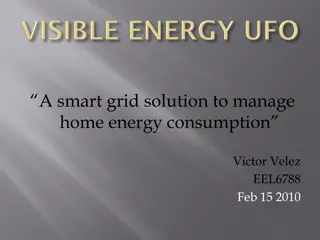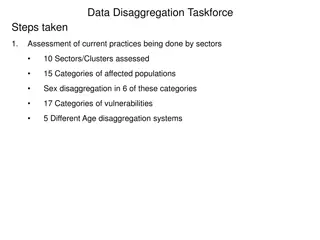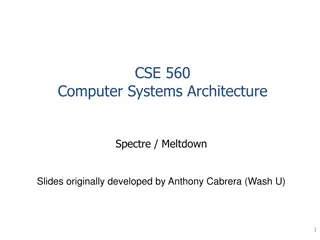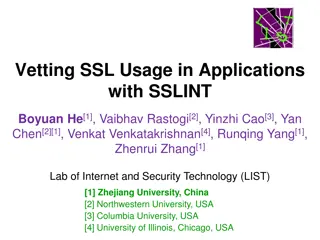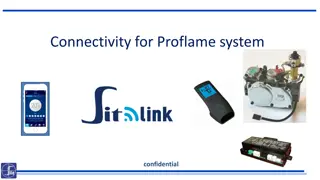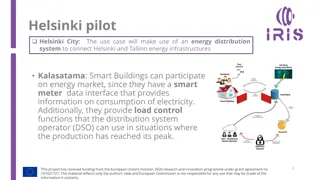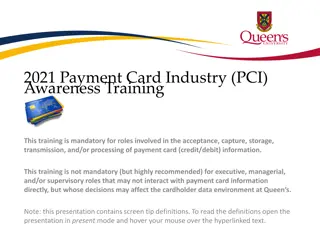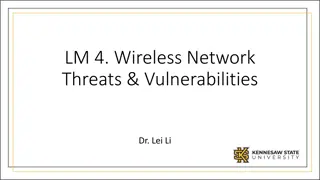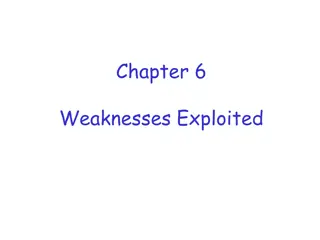Smart Bathtub Vulnerabilities and Remote Control Risks
Explore the risks associated with a remote-controlled bathtub controlled via a smartphone app, including vulnerabilities in controlling water flow, water level sensing, and potential overflow scenarios. Learn how attackers could manipulate signals wirelessly and the likelihood of causing the bathtub to overflow based on compromised system links.
Download Presentation

Please find below an Image/Link to download the presentation.
The content on the website is provided AS IS for your information and personal use only. It may not be sold, licensed, or shared on other websites without obtaining consent from the author. Download presentation by click this link. If you encounter any issues during the download, it is possible that the publisher has removed the file from their server.
E N D
Presentation Transcript
Modeling a remote-controlled bathtub and identifying vulnerabilities Roger L. Costello August 29, 2018
Smartphone app controls bathtub Using a Smartphone app you can control the water into and out of the bathtub, so the bath will be all ready for you when you get home.
App controls water valve and drain Electronic devices in the water valve and in the drain enable the app to (wirelessly) control the flow of water into and out of the bathtub.
App receives water level sensor data Water level sensor A water level sensor on the bathtub transmits these water level values: {empty, LL, L, M1, M2, H, HH, OF} OF = OverFlow
Behavior of the bathtub system When the water valve is turned on and the drain is closed, the water level in the tub increases. When the water valve is turned off and the drain is open, the water level in the tub decreases. When the water valve is turned on and the drain is open, the water level in the tub remains the same. When the water valve is turned off and the drain is closed, the water level in the tub remains the same.
Alarm goes off if An alarm goes off on the app if the water in the tub is about to overflow. The bathtub is overflowing when the water level = OF for 3 consecutive time steps.
Attacker capabilities The smartphone app interacts with the bathtub system wirelessly. An attacker is able to intercept and replace signals sent between the smartphone app and the bathtub system.
Can an attacker cause the tub to overflow? An attacker wants to cause the tub to overflow. Note that the fewer things that the attacker has the compromise, the more likely the attack. For example, if the attacker has to compromise the link to the water valve and the link to the drain and the link from the water level sensor, then that greatly reduces the likelihood of an attack than if, say, the attacker just needs to compromise the water level sensor.
Alloy Analyzer searches for vulnerabilities I created an Alloy model of the system and had the Alloy Analyzer explore all possible attack configurations and enumerate ones that lead into an unsafe state, i.e., a configuration which results in the bathtub overflowing. The Analyzer found multiple ways that an attacker can cause the bathtub to overflow. The simplest way (for the attacker) is to compromise the data transmissions from the water level sensor to the app.
App receives water level data from attacker Water level sensor X water level Attacker
The app thinks everything is fine App Bathtub Time Valve Level Drain Time Valve Level Drain Time0 Off empty Open Time0 Off empty Open Time1 On empty Closed Time1 On empty Closed Time2 On LL Closed Time2 On LL Closed Time3 On L Closed Time3 On L Closed Time4 On M1 Closed Time4 On M1 Closed Time5 On M2 Closed Time5 On M1 Closed Time6 On H Closed Time6 On M1 Closed Time7 On HH Closed Time7 On M1 Closed Time8 On OF Closed Time8 On M1 Closes Time9 On OF Closed Time9 On M1 Closed Time10 On OF Closed Time10 On M1 Closed Time11 On OF Closed Time11 On M1 Closed Actual water level, as measured by the water level sensor Water level values sent by attacker Compromised: water level sensor
One Bathtub, one App onesig Bathtub { valve: WaterValve one -> Time, level: WaterLevel one -> Time, drain: Drain one -> Time } onesig App { valve: WaterValve one -> Time, level: WaterLevel one -> Time, drain: Drain one -> Time }
One value at each time onesig Bathtub { valve: WaterValve one -> Time, level: WaterLevel one -> Time, drain: Drain one -> Time } onesig App { valve: WaterValve one -> Time, level: WaterLevel one -> Time, drain: Drain one -> Time } At each time step the bathtub has exactly one WaterValve value, one WaterLevel value, and one Drain value. Ditto for the App.
Enumerate the allowable values enum Drain {Open, Closed} enum WaterValve {On, Off} enum WaterLevel {empty, LL, L, M1, M2, H, HH, OF}
App tells the water valve to turn on/off The App determines whether the water valve should be on or off. So, Bathtub.valve equals App.valve, if the connection is not compromised (more precisely, if the water valve actuator is not compromised).
Enumerate the devices that might be compromised enum Device {DrainActuator, WaterValveActuator, WaterLevelSensor} sig Compromised in Device {}
Threat model A threat model describes a set of actions that an attacker may perform in an attempt to compromise a security property of a system. Building a threat model is an important step in any secure system design; it allows us to identify (possibly invalid) assumptions that we have about the system and its environment and prioritize different types of risks that need to be mitigated. Acknowledgement: Eunsuk Kang
App tells the drain to open/close The App determines whether the drain should be open or closed. So, Bathtub.drain equals App.drain, if the connection is not compromised (more precisely, if the drain actuator is not compromised).
Behavior of the bathtub system Bathtub.valve equals App.valve, if the WaterValveActuator is not compromised. Bathtub.drain equals App.drain, if the DrainActuator is not compromised. When the water valve is turned on and the drain is closed, the water level in the tub increases. When the water valve is turned off and the drain is open, the water level in the tub decreases. When the water valve is turned on and the drain is open, the water level in the tub remains the same. When the water valve is turned off and the drain is closed, the water level in the tub remains the same.
onesig Bathtub { valve: WaterValve one -> Time, level: WaterLevel one -> Time, drain: Drain one -> Time }{ all t : Time { -- If the data packets controlling the water valve actuator are not compromised, -- then the bathtub's water valve is the value provided by the App. (WaterValveActuator notin Compromised) implies valve.t = App.valve.t -- If the data packets controlling the drain actuator are not compromised, -- then the bathtub's drain is the value provided by the App. (DrainActuator notin Compromised) implies drain.t = App.drain.t } -- However the water valve and drain obtain their values (via the App or via an attacker), -- the bathtub's water level is determined by their settings. all t : Time - last | let t' = t.next { (valve.t = On and drain.t = Open) implies (level.t' = level.t) (valve.t = Off and drain.t = Closed) implies (level.t' = level.t) (valve.t = On and drain.t = Closed) implies (level.t' = increaseLevel[level.t]) (valve.t = Off and drain.t = Open) implies (level.t' = decreaseLevel[level.t]) } }
App receives water level data from sensor Water level sensor The App receives data from the water level sensor. So, App.level equals Bathtub.level, if the connection is not compromised (more precisely, if the water level sensor is not compromised).
App sends on command when Water level sensor Send an on command when the App s water level value indicates a low level or when the valve is already on and the water level is not high.
Behavior of the App At each time step, the App s water level reading equals the bathtub s water level, provided WaterLevelSensor is not compromised. If WaterLevelSensor is compromised, then the App still receives a water level value, but the value comes from the attacker, not the bathtub. Send an valve on command when the level reading is empty, LL, or L. If the valve is already on, then leave it on provided the level is not H, HH, or OF. To send a valve on command simply means set App.valve equal to on . We abstract away the operations of sending/receiving wireless packets. Send a valve off command when the level reading is H, HH, or OF. If the drain is already off, then leave it off provided the level is not empty, LL, or L. Continued
Behavior of the App (cont.) Send an open drain command when the level reading is H, HH, or OF. If the drain is already open, then leave it open provided the level is not empty, LL, or L. Send a close drain command when the level reading is empty, LL, or L. If the drain is already closed, then leave it closed provided the level is not H, HH, or OF.
onesig App { valve: WaterValve one -> Time, level: WaterLevel one -> Time, drain: Drain one -> Time }{ all t : Time { -- If the data packets from the bathtub's water level sensor are not compromised, -- then the app's water level reading is the value provided by the Bathtub. (WaterLevelSensor notin Compromised) implies level.t = Bathtub.level.t } all t : Time - last | let t' = t.next { drain.t' = Open iff ( (drain.t = Open andnot (level.t in (empty + LL + L))) or level.t in (H + HH + OF) ) drain.t' = Closed iff ( (drain.t = Closed andnot (level.t in (H + HH + OF))) or level.t in (empty + LL + L) ) valve.t' = On iff ( (valve.t = On andnot (level.t in (H + HH + OF))) or level.t in (empty + LL + L) ) valve.t' = Off iff ( (valve.t = Off andnot (level.t in (empty + LL + L))) or level.t in (H + HH + OF) ) } }
Overflow alarm raised when water level = OF Water level sensor The App raises an overflow alarm at time t if the App s water level reading value is OF (OverFlow) at time t. Of course, an attacker wants to avoid the alarm being raised, so he will manipulate the signals such that the App never gets into an overflow condition.
Declare Alarm abstractsig Alarm { raised: Time } sig Overflow extends Alarm {}
Condition for generating alarm fact { // if the water level reads OF, raise the overflow alarm all t : Time | App.level.t = OF impliessome Overflow & raised.t elseno Overflow & raised.t }
Initial state of App and bathtub fact init { no Alarm & raised.first App.valve.first = Off App.drain.first = Open Bathtub.level.first = empty }
onesig Bathtub { valve: WaterValve one -> Time, level: WaterLevel one -> Time, drain: Drain one -> Time }{ all t : Time { -- If the data packets controlling the water valve actuator are not compromised, -- then the bathtub's water valve is the value provided by the App. (WaterValveActuator notin Compromised) implies valve.t = App.valve.t How to define these? -- If the data packets controlling the drain actuator are not compromised, -- then the bathtub's drain is the value provided by the App. (DrainActuator notin Compromised) implies drain.t = App.drain.t } -- However the water valve and drain obtain their values (via the App or via an attacker), -- the bathtub's water level is determined by their settings. all t : Time - last | let t' = t.next { (valve.t = On and drain.t = Open) implies (level.t' = level.t) (valve.t = Off and drain.t = Closed) implies (level.t' = level.t) (valve.t = On and drain.t = Closed) implies (level.t' = increaseLevel[level.t]) (valve.t = Off and drain.t = Open) implies (level.t' = decreaseLevel[level.t]) } }
-- step function that takes a water level and returns the next higher one fun increaseLevel : WaterLevel -> WaterLevel { levelOrder + OF -> OF } -- step function that takes a water level and returns the next lower one fun decreaseLevel : WaterLevel -> WaterLevel { ~levelOrder + empty -> empty } -- total ordering on the water levels: empty, LL, L, M1, M2, H, HH, OF fun levelOrder : WaterLevel -> WaterLevel { empty -> LL + LL -> L + L -> M1 + M1 -> M2 + M2 -> H + H -> HH + HH -> OF } Acknowledgement: Eunsuk Kang
3 consecutive time steps with level = OF // Bathtub overflows if the water level is OF for 3 times // and no alarm is raised pred overflow[t : Time] { let t0 = t.prev.prev, t1 = t.prev, t2 = t { some t0 andsome t1 andsome t2 Bathtub.level.(t0 + t1 + t2) = OF and no Overflow & raised.(t0 + t1 + t2) } }
Run the Alloy Analyzer run generateOverflowAttack { #Compromised <= 1 some t : Time | overflow[t] } for 1 but 12 Time, 12 Alarm
Bathtub overflows! App Bathtub Time Valve Level Drain Time Valve Level Drain Time0 Off empty Open Time0 Off empty Open Time1 On empty Closed Time1 On empty Closed Time2 On LL Closed Time2 On LL Closed Time3 On L Closed Time3 On L Closed Time4 On M1 Closed Time4 On M1 Closed Time5 On M2 Closed Time5 On M1 Closed Time6 On H Closed Time6 On M1 Closed Time7 On HH Closed Time7 On M1 Closed Time8 On OF Closed Time8 On M1 Closes Time9 On OF Closed Time9 On M1 Closed Time10 On OF Closed Time10 On M1 Closed Time11 On OF Closed Time11 On M1 Closed Compromised: water level sensor
Filling up and draining a bathtub is analogous to filling up and draining a water tank at a water treatment plant Raw Water Motorized Valve Raw Water Tank other stuff Pump


